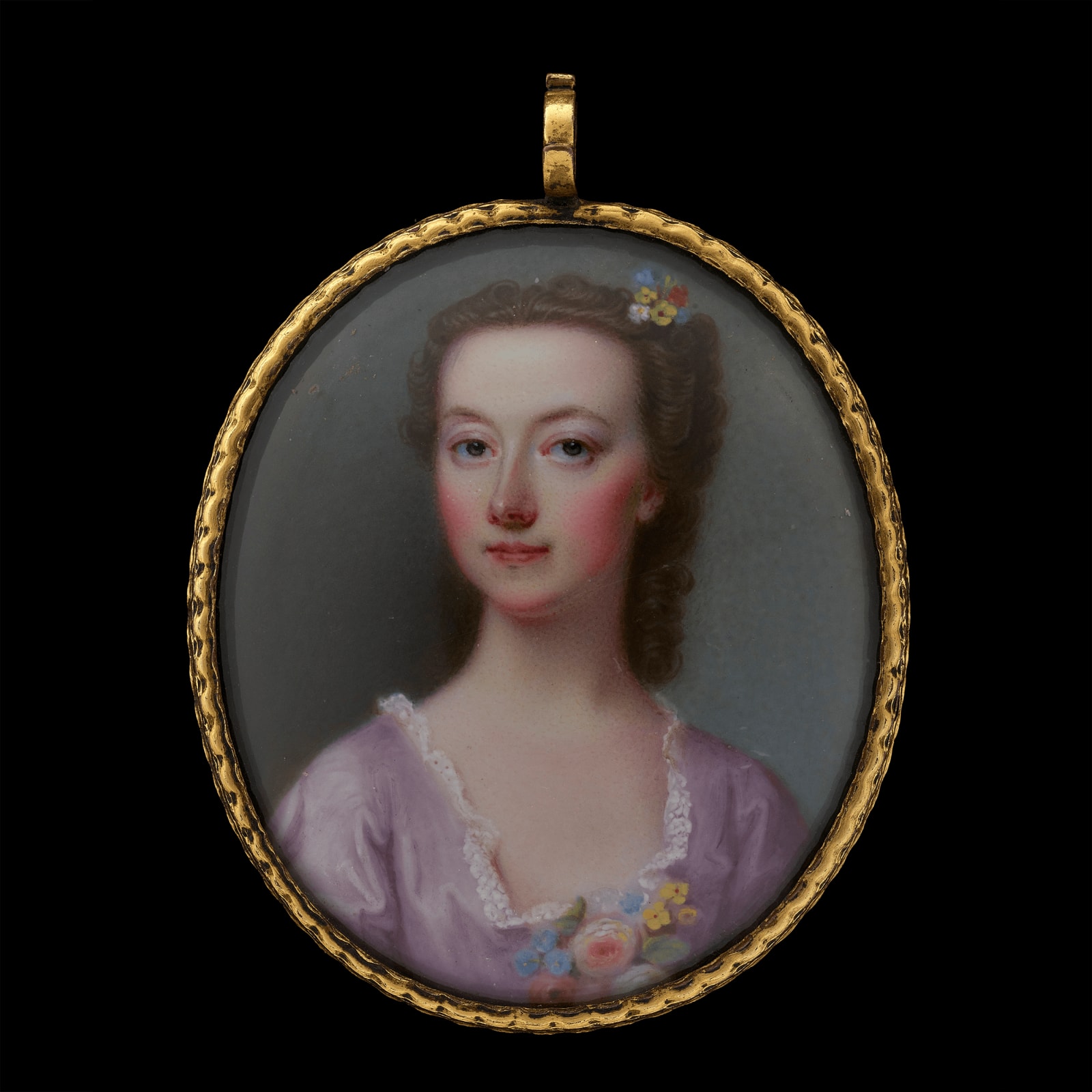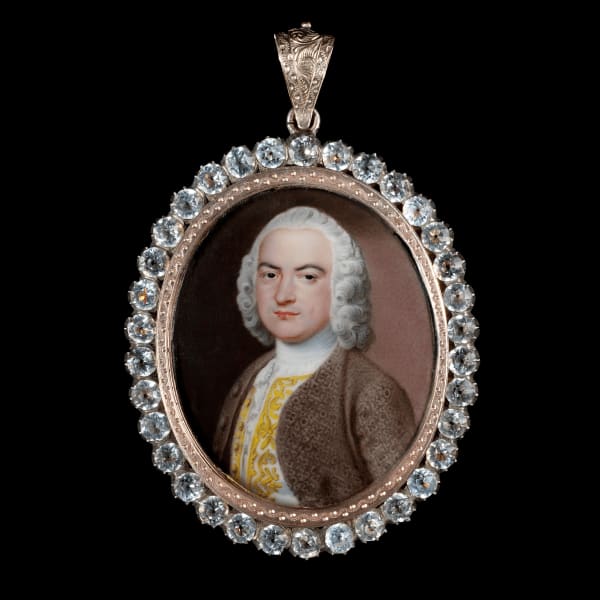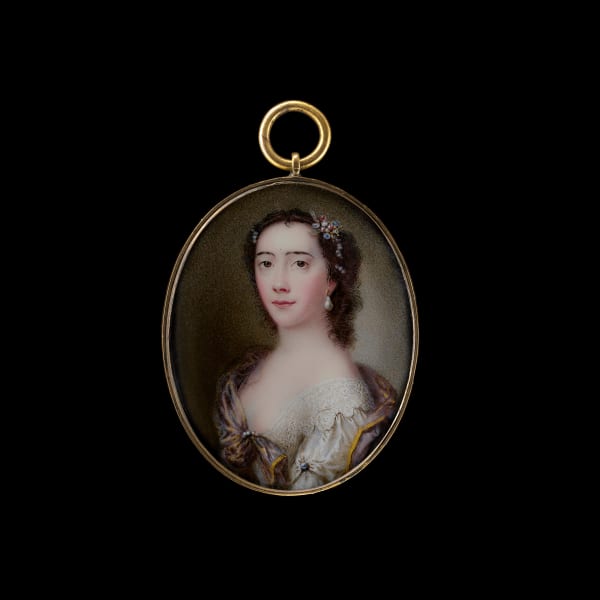
Jean André Rouquet
A young Lady, wearing pale pink dress, flowers at her corsage and in her curled hair, c. 1740
Enamel on metal
Oval, 1.6 in. (41 mm) high
Philip Mould & Co.
%3Cdiv%20class%3D%22artist%22%3EJean%20Andr%C3%A9%20Rouquet%3C/div%3E%3Cdiv%20class%3D%22title_and_year%22%3E%3Cspan%20class%3D%22title_and_year_title%22%3EA%20young%20Lady%2C%20wearing%20pale%20pink%20dress%2C%20flowers%20at%20her%20corsage%20and%20in%20her%20curled%20hair%3C/span%3E%2C%20%3Cspan%20class%3D%22title_and_year_year%22%3Ec.%201740%3C/span%3E%3C/div%3E%3Cdiv%20class%3D%22medium%22%3EEnamel%20on%20metal%3C/div%3E%3Cdiv%20class%3D%22dimensions%22%3EOval%2C%201.6%20in.%20%2841%20mm%29%20high%3C/div%3E
To view all current artworks for sale visit philipmould.com
Born in Switzerland, Rouquet travelled to London in his early 20s, where he painted portraits in enamel. His friendship with his close contemporary, the artist William Hogarth (1697-1764), whom he painted in a superbly naturalistic enamel [NPG 5717], may have resulted in some of his commissions. The collection of the Victoria and Albert Museum, holds a portrait of William Pitt (1708-1778), 1st Earl of Chatham [P.5-1946], painted at a similar date to the present work.
Rouquet’s sitters appear to vary from wealthy merchants to nobility and like Hogarth he rarely flattered his sitters. Genuinely attractive subjects, such as the portrait of the young lady here, are rare amongst his oeuvre, and the addition of fresh flowers by the artist is perhaps an indication that such natural beauty should be treasured while it lasts.
Rouquet moved to Paris in 1752 where, in 1755, he published his L’État des arts en Angleterre, which was immediately translated into English. After exhibiting five enamels at the Académie in 1753 he was given an apartment in the Louvre. In 1758, reports of his dangerous and manic behaviour from his fellow artists lodging at the Louvre resulted in his incarceration in the Charenton, where he died a few months later.[1]
[1] A fascinating account of this incident and the consequences for Rouquet is revealed in D. Maskill’s article The Neighbor from Hell: André Rouquet’s Eviction from the Louvre, published in ‘Journal 18’, Issue #2, Fall 2016
Born in Switzerland, Rouquet travelled to London in his early 20s, where he painted portraits in enamel. His friendship with his close contemporary, the artist William Hogarth (1697-1764), whom he painted in a superbly naturalistic enamel [NPG 5717], may have resulted in some of his commissions. The collection of the Victoria and Albert Museum, holds a portrait of William Pitt (1708-1778), 1st Earl of Chatham [P.5-1946], painted at a similar date to the present work.
Rouquet’s sitters appear to vary from wealthy merchants to nobility and like Hogarth he rarely flattered his sitters. Genuinely attractive subjects, such as the portrait of the young lady here, are rare amongst his oeuvre, and the addition of fresh flowers by the artist is perhaps an indication that such natural beauty should be treasured while it lasts.
Rouquet moved to Paris in 1752 where, in 1755, he published his L’État des arts en Angleterre, which was immediately translated into English. After exhibiting five enamels at the Académie in 1753 he was given an apartment in the Louvre. In 1758, reports of his dangerous and manic behaviour from his fellow artists lodging at the Louvre resulted in his incarceration in the Charenton, where he died a few months later.[1]
[1] A fascinating account of this incident and the consequences for Rouquet is revealed in D. Maskill’s article The Neighbor from Hell: André Rouquet’s Eviction from the Louvre, published in ‘Journal 18’, Issue #2, Fall 2016
Provenance
Private British Collection
Share
- X
- Tumblr
Related artworks
-
 Pierre Adolphe HallA young Lady, wearing blue bodice over white blouse, c. 1770
Pierre Adolphe HallA young Lady, wearing blue bodice over white blouse, c. 1770 -
 Richard CoswayA Lady, wearing white muslin dress with high collar and yellow belt, her hair powdered, c. 1780
Richard CoswayA Lady, wearing white muslin dress with high collar and yellow belt, her hair powdered, c. 1780 -
 Jean André RouquetPortrait enamel of a Gentleman, wearing brown coat over white waistcoat embroidered with gold thread, powdered wig, c. 1740
Jean André RouquetPortrait enamel of a Gentleman, wearing brown coat over white waistcoat embroidered with gold thread, powdered wig, c. 1740 -
 Nathaniel Hone the ElderA portrait enamel of a Lady, traditionally thought to be Mary Boyle, Countess of Cork and Orrery (1746–1840), wearing pink dress with lace collar and black bow held with double row of pearls, further pearls decorate her upswept hair, c. 1760
Nathaniel Hone the ElderA portrait enamel of a Lady, traditionally thought to be Mary Boyle, Countess of Cork and Orrery (1746–1840), wearing pink dress with lace collar and black bow held with double row of pearls, further pearls decorate her upswept hair, c. 1760 -
 Rupert BarberA Lady, wearing a gold-trimmed lilac shawl over a white dress, c. 1745
Rupert BarberA Lady, wearing a gold-trimmed lilac shawl over a white dress, c. 1745 -
 Christian Friedrich ZinckeA Nobleman, probably a member of the Townshend family, c. 1740
Christian Friedrich ZinckeA Nobleman, probably a member of the Townshend family, c. 1740





